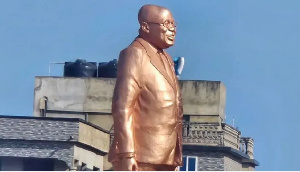Opinions of Friday, 20 September 2013
Columnist: Kumi, Frank
Marijuana and Cigarette Smoking
: Correcting the Imbalance Scale of Legality
After decades of enjoying exclusive gushing glorification and relentless advocacy in a certain genre of music, current trends in legal enactments of certain western countries covering marijuana seem to be echoing the long-held epicurean views of its exponents. Unfortunately, same cannot be said of the purely legit cigarette tobacco as a maze of stiff regulations is enacted as a measure to underscore the perilous health implications it poses to its aficionados—and innocent bystanders alike.
Citing various reasons, a relatively appreciable number of jurisdictions have set out to formulate legislations that would seminally decriminalize the possession, sale and use of marijuana, paving a circumscribed latitude for the once highly regarded illicit substance to be used in namely two broad ways: recreational and medical purposes. An article by one Michael Schatman, PhD, “Medical Marijuana: The Imperative of Educating Physicians” (2013, medscape.com) cited a source indicating that “Medical marijuana is legal in 20 states and the District of Columbia, with pending legislation to legalize the drug for medical purposes in 4 others.”
In July this year, Uruguay reportedly took a radical approach in joining a bloc of pot-crusading countries such as US (not on the federal level but in some states), Netherlands, Jamaica, North Korea, Portugal, Spain, Belgium, Russia, Pakistan etc.
A cursory zoom into the legal realm of tobacco use however tells a different tale. Taking a paradoxical approach to the usual way of commemorating world events, the World Health Organization (WHO) in 1987 adopted May 31 on its annual calendar as World No Tobacco Day. The intention is to give tobacco a 24-hour wide berth on this particular day as well as to draw global attention to the ghastly health effects of this “poison.”
In furtherance of this anti-tobacco campaign, WHO Framework Convention on Tobacco (WHO FCTC) treaty was born and adopted by the 56th World Health Assembly on 21 May, 2003. The treaty, ratified by 177 member countries is described as one of the “most quickly ratified treaties in United Nations history,” and aims “to protect present and future generations from the devastating health, social, environmental and economic consequences of tobacco consumption and exposure to tobacco smoke.” One country, Bhutan, has pushed the legal boundaries further by completely proscribing the cultivation, harvesting, production and sale of tobacco and tobacco products. In March 2012, Brazil also followed suit by becoming the “world's first country to ban all flavored tobacco including menthols.”
On the local front, in January 2012, Ghana would join a host of countries-- Russia, US, China, Ireland, Italy, India etc—that would epically tighten its legislation on the sale, advertisement, display, packaging and use of tobacco when it passed the Public Health Act, 2012, Act 851; the Part Six—Tobacco Control Measures--specifically devoted to this quest. As a sequel to this law, the Chief Executive Officer of the Food and Drugs Authority (FDA) in an official edict declared that his regulatory agency, through the arrest and persecution of offenders of this law would “ensure that non-smokers are protected from the tobacco smoke [and] from smokers considering the overwhelming evidence of the harmful effects of breathing tobacco smoke.”
Despite the apparent trending inverse relationship between the legal path of tobacco and dope (as marijuana is affectionately called in the streets), one should not be hastily tempted to surmise that the usual presumption of “natural” being synonymous with “safety” would be applicable here. This would be akin to leaping without a safety net as either has evidently been linked to negative psychological effects, for which main reason marijuana was coarsely classified as a Schedule I drug under the Narcotic Drugs (Control, Enforcement and Sanctions) Law 1990 (PNDCL 236). Like tobacco, cannabis can cause dependence—if not addiction.
It is also worth noting that as with any other foreign substance taken into the body; both are not spared the potential adverse effects these materials may present. Overwhelming bodies of literature and clinical evidence have strongly linked tobacco use to cancer-, lung-related and cardiovascular diseases (heart attack, stroke etc). In fact, according to WHO, cigarette smoking is currently the second largest cause of death in the world. When it comes to the adverse effects of cannabis on the body, its psychoactive effects-- paranoia, panic, and anxiety—still reign heavily.
Notwithstanding the tenuous similarities in some respects, there is an unconscious effort aimed at tilting the scale of legality in preference to marijuana, while attempting a compelling justification of its legitimization anchored on proven medical and theorized economic benefits in the wake of unconvincingly speculative negative impact.
A comprehensive study, led by University of California, San Francisco (UCSF) and University of Alabama, comparing the toll on lung function between marijuana and tobacco, in January 2012, showed marijuana “to be less damaging to [the] lungs than tobacco.” The study unsurprisingly reaffirmed the “consistent loss of lung function with increasing exposure” associated with tobacco. Lead author of the paper, Mark Pletcher (MD, MPH), contended the authors were however surprised they found “such a different pattern of association with marijuana exposure.” Air flow rate--a marker for lung function--increased rather than decreased with increased exposure to marijuana up to a certain level.
As tobacco is inexorably being maligned--and battered--for all the infamous reasons, dope is surprisingly turning out to be the panacea, providing unplowed grounds for treating certain medical conditions. A November 2012 research spanning almost twenty years would further give a ringing acclamation to the medical benefits of marijuana: A pair of scientists at California Pacific Medical Center in San Francisco found that a compound derived from marijuana—Cannabidiol--could stop metastasis (cancer spread) in many kinds of aggressive cancer, potentially altering the fatality of the disease forever. Pre-human study of this compound “found no toxicity” in animals tested, according study authors.
Even though this is regarded by some as a mere curtain-raiser to the medicinal benefits of marijuana, it definitely adds more laurels to those already tacked under its belt since its insidious acceptance into the medical community. Already, states that approved cannabis use did it on therapeutic grounds that the substance is clinically proven worthy in chronic pain management, glaucoma, AIDS wasting, neuropathic pain, treatment of spasticity associated with multiple sclerosis, and chemotherapy-induced nausea. For example, in California, medical doctors could actually give a pass or a prescription for patients smitten with any of these conditions to access dope from pot-designated dispensaries.
Economic benefits amidst a factoid of danger posed by marijuana legalization seem to be conferring on the medical piety and deference gradually being accorded the substance. When his opinion was sought in an article “Legalizing Marijuana: Putting the Cart before the Horse?” (2012, medscape.com), Dr Seth Flesher (MD, St. Luke's-Roosevelt Hospital, New York City) was of the proposition that “The cost to society of people having jail records and not being able [to] find work, being separated from their families, and the financial stress of enforcement in this era of government austerity trumped the possible dangers of cannabis." Indeed, it is well acknowledged that the overzealous outlawing of cannabis users against the back drop of its scanty and poorly researched negative toll glaringly serves no nation good. Matt Jenkins, a High Country News journalist reported in his story “Ganjanomics: bringing Humboldt's shadow economy into the light” that California has been able to “generate $1.4 billion for state coffers” since the “legalize-and-tax mantra” was bravely adopted in this state.
There may be some frail similarities existing between tobacco, a purely legal substance, and marijuana, a complete ostracized vice. But given the opposite legal trajectory of both substances, coupled with the unique percolation and resounding acclimatization of the medical community to one over the other, it makes perfect sense that the scale of legality is gradually being tilted in favor of ganja.
By:
Frank Kumi
Registered Pharmacist
Tamale Teaching Hospital
Contact: macfancy2g4@yahoo.com
Entertainment









